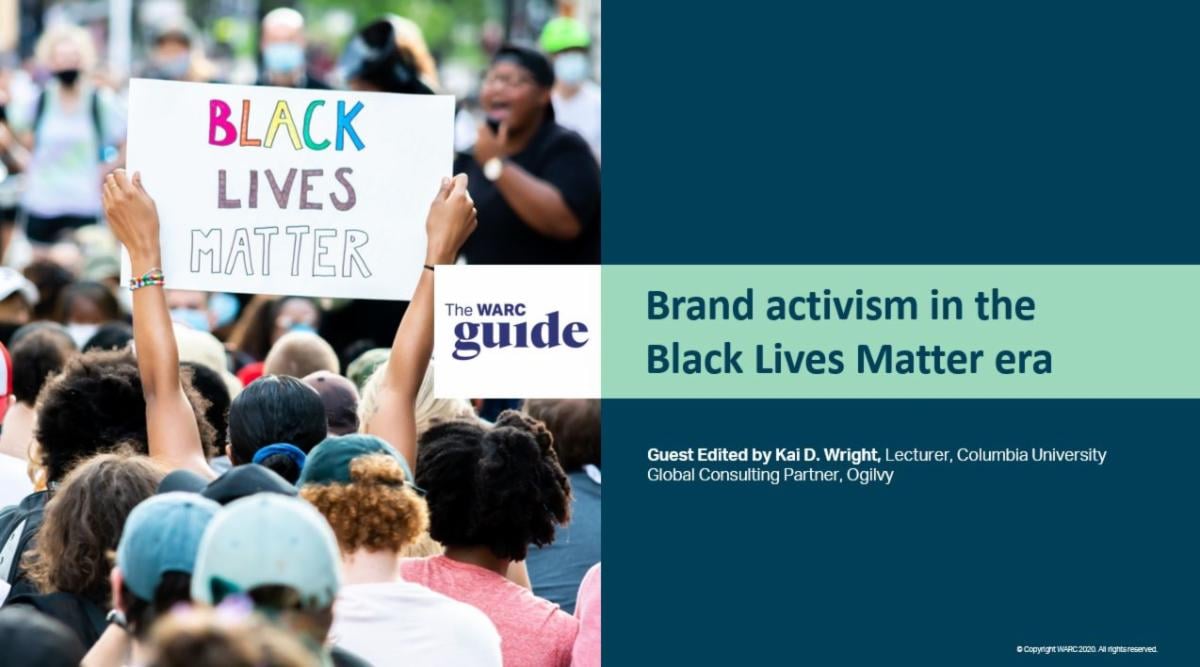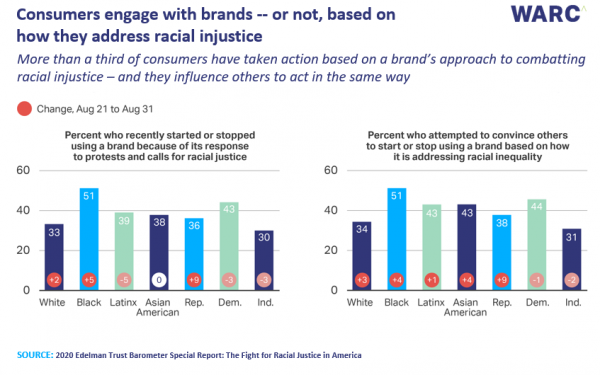
The Black Lives Matter movement has galvanized consumers and employees, demanding brands to identify and double-down on how they respond to racial injustice. Brands now look to move forward effectively in a way that provides empathy, earnestness and empowerment in their engagement with Black communities.
To help marketers navigate these challenges and lead with purpose, WARC, the global authority on marketing effectiveness, has released the WARC Guide to Brand activism in the Black Lives Matter era, compiling insights and learnings from prominent Black voices in the marketing community.
 Guest editor Kai D. Wright, Columbia University Lecturer, Ogilvy Global Consulting Partner, Author and Founder of blacklist 100, comments: “From the streets to boardrooms, Black Lives Matter has unified consumers and employees in fighting racial inequity, demanding more accountability from CEOs, organizations, and brands themselves.
Guest editor Kai D. Wright, Columbia University Lecturer, Ogilvy Global Consulting Partner, Author and Founder of blacklist 100, comments: “From the streets to boardrooms, Black Lives Matter has unified consumers and employees in fighting racial inequity, demanding more accountability from CEOs, organizations, and brands themselves.
“In the next 30 years, 90% of the US population growth will come from minority audiences, including Black households. This Guide offers research, inspiration, and advice on how to exercise brand accountability. Ultimately, it is a quick-start foundation for ethically activating Black Lives Matter to be relevant among, and resonate with, diverse communities by creating a new growth imperative based on their empowerment.”
 Cathy Taylor, US Commissioning Editor, WARC, says: “Research shows consumers are demanding brands respond in ways that go beyond donations. This is not just about changing messaging or momentary gestures, it is about the very core of the business ⧿addressing challenges and taking the right steps to drive long term positive change.
Cathy Taylor, US Commissioning Editor, WARC, says: “Research shows consumers are demanding brands respond in ways that go beyond donations. This is not just about changing messaging or momentary gestures, it is about the very core of the business ⧿addressing challenges and taking the right steps to drive long term positive change.
“We are delighted to have worked with guest editor Kai and our many esteemed contributors in our quest to help businesses respond in authentic and meaningful ways to the BLM movement.”
Providing guidance for advertisers, agencies and media owners, the report features case studies from brands who’ve done it well – including, Procter & Gamble, Ford and Netflix – data on changing attitudes around Black Lives Matter, what consumers want brands to do, the internal work that brands have to do towards diversity, equity and inclusion, and how that affects marketing outcomes.
The eight key takeaways highlighted in WARC’s Guide to Brand activism in the Black Lives Matter era are:
1. The US is moving toward a majority-minority culture
According to US Census data, in 2014 minorities made up 38% of the country, but by 2060 they will be in the majority at 56%. Marketers should no longer default to white culture. Non-US marketers should note the call for better representation is present in many markets, and lessons from the next wave of brand activism will be relevant globally.
2. Black Lives Matter is bigger than messaging, affecting how brands operate internally and externally
It is not just a multicultural issue; it’s a human rights issue. And it’s not just about posting a black square in protest on Instagram. For some brands, confronting racial injustice is new territory, but other brands came prepared. What they share is a strong brand purpose and often a history of addressing social issues.
3. Addressing racial injustice is a business imperative
More than a third of consumers have taken action based on a brand’s approach to combating racial injustice – and they influence others to act in the same way. Especially in younger demographics, people say they will vote with their wallets and voices in terms of what brands they purchase.

4. Brands need to accept discomfort and be prepared for polarization in addressing racial inequities
Consumers firmly want brands to show solidarity but are torn as to what pace or scale. According to PSB Insights, there is clear polarization around how brands are seen as “responding to the current conversations and protests around racial injustice”.
5. Ads that reflect diversity work
A global analysis of over 11,000 ads on Kantar’s Link platform showed ads are more likely to get viewers’ attention and be remembered if they feature people from diverse backgrounds. They’re more enjoyable and involving, and show sales benefits.
6. A brand purpose, alone, is not enough
It only works when brands show true commitment and willingness to change. Visa, Levi’s and P&G are committing to diversity, equity, and inclusion (DEI). Visa is reviewing progress every quarter.
7. Media budgeting is overwhelmingly skewed toward the general population
Only 6% of all US media spend of the total $480bn per year is geared toward minority groups. Brands need to act on bringing more equity to media investment.
8. Consumers prefer concrete action
Consumers prefer community investments and internal diversity, over donations. Research by WARC and Wunderman Thompson shows that of 1,006 adults surveyed in the US from Sept 3-9, 47% of Black/African American versus 32% of the general population want brands to change current internal practices and policies.
A sample of the WARC Guide to Brand activism in the Black Lives Matter era is available to download here. The full report is available to WARC subscribers.
To complement the Guide, WARC will host two webinars: October 27 with Monique Nelson, Chair and CEO at UWG and Kai D. Wright entitled Marketing to Multicultural Consumers Now and in the Coming Majority-Minority; October 28 with Kantar entitled A Global look at Racial Representation in Advertising.
 Paul Coxhill, Managing Director, WARC & Lions Intelligence, added: “WARC is committed to help advance diversity and inclusion in our industry. This Guide, together with our other BLM initiatives, will help brands, agencies, as well as the next generation of marketers, address the challenges and take the right steps to drive long term positive change.”
Paul Coxhill, Managing Director, WARC & Lions Intelligence, added: “WARC is committed to help advance diversity and inclusion in our industry. This Guide, together with our other BLM initiatives, will help brands, agencies, as well as the next generation of marketers, address the challenges and take the right steps to drive long term positive change.”
In response to the Black Lives Matter movement, WARC has joined forces with Cannes Lions and industry bodies to partner with the HBCU Business Deans Roundtable in the US to support future Black marketers, as well as partnering with the Black Cultural Archives (BCA) in the UK to produce the video series Hidden Figures: A look at Black British Marketing & Design (released from Oct 15). More information here









